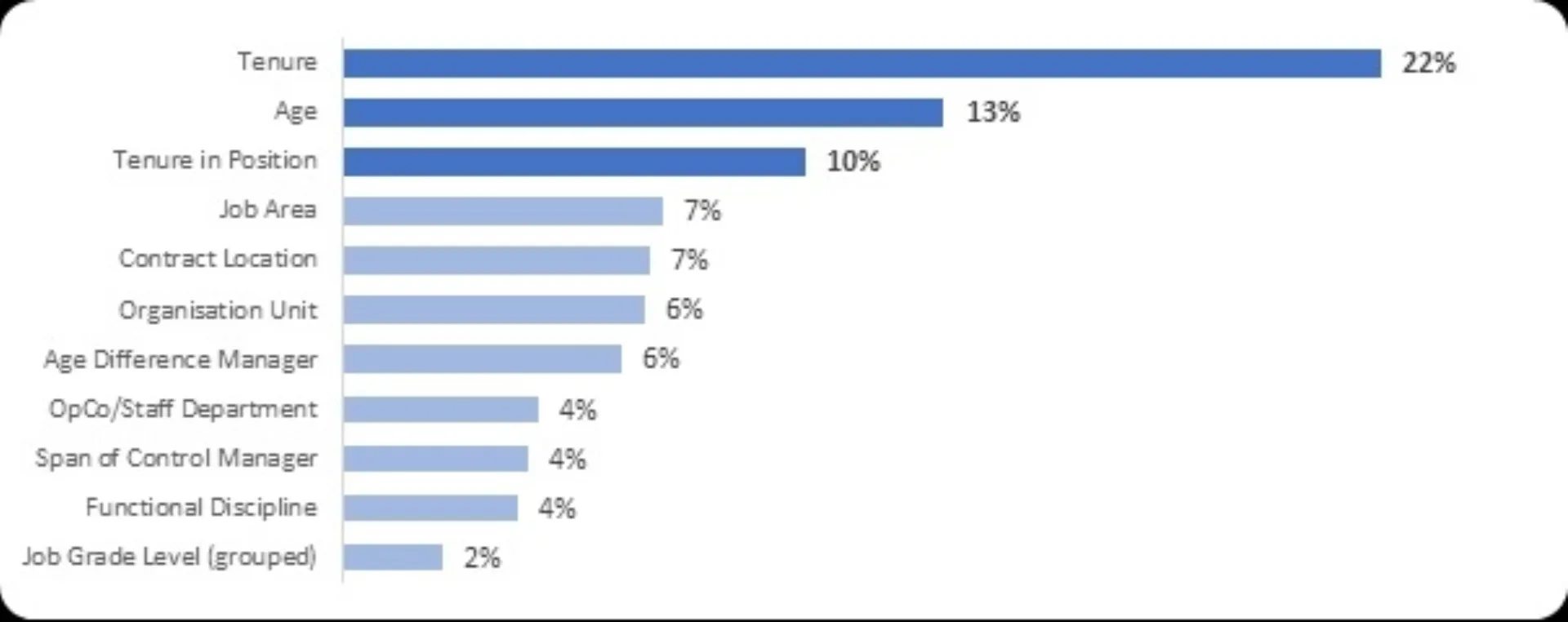Efficiently reduce employee turnover with data-driven retention strategies
The labor market is tight and the 'war on talent' is in full swing. Hiring and training new employees not only takes time and money, but the loss of valuable talent can also disrupt business continuity and negatively impact the morale of remaining employees. It is therefore understandable that organizations wonder what the most efficient ways are to retain employees and thus minimize the negative consequences of turnover.
An organization often makes assumptions about employee turnover, for example, mainly younger and recently hired employees would leave and the only way to retain these groups would be to offer them better compensation. However, companies often have no concrete substantiation for these assumptions. A market-leading organization in the dairy industry faced a similar scenario, with the company experiencing significantly high voluntary turnover on a global scale. In this situation, AnalitiQs was called in to work with the client to answer two crucial questions: (1) What is the situation regarding voluntary turnover in our organization and (2) how can we reduce this turnover?

Daily insights into employee departures
The status quo consisted of separate lists summarizing turnover information, manually and laboriously updated every month, providing limited insights and requiring manual sharing with HR Business Partners.
In collaboration with the client, organizational needs were identified as the basis for developing a PowerBI dashboard. This new tool now supports end-users in their daily tasks. Thanks to the automatic daily update of the dashboard and the fact that end-users can now answer ad-hoc questions themselves, additional hours are available for the HR Analytics team each month.
With the implementation of the PowerBI dashboard, end-users have access to real-time information about turnover without depending on manual updates. This enables them to quickly understand trends, patterns, and specific data about employee departures. Moreover, they can now independently conduct analyses and extract relevant information to support decision-making.
Identifying the Drivers of Voluntary Turnover
The dashboard insights allow exploration of outliers and relationships in turnover. For example, the average turnover per age group can provide insights into which age group the organization can focus on or reveal that turnover decreases as employees get older. These valuable insights, however, leave the question of what makes the biggest difference unanswered.
To determine the greatest influence, the effects of factors on turnover need to be examined together. Thus, a 'multivariate' statistical model, examining the effects of variables on turnover simultaneously, can show, for example, how significant the effect of age is when looking at all other variables at the same time. Using this method, a list of the top 10 drivers of voluntary turnover has emerged.

With these insights, strategies can be tested to support these factors, such as reducing the span of control of managers or matching leadership and subordinates based on age. Additionally, factors highlighted as significant can be further investigated and given higher priority in addressing turnover.
To further refine prioritization, the top 10 drivers were used to create risk groups, illustrating the average turnover of groups where 'risks,' such as a short length of employment, a high span of control from their manager, and a high job level, are added together. This way, the groups with the highest risk of leaving are identified, allowing the organization to proactively address their departure by taking measures and targeting these groups specifically.
Adjusting the Knobs
Strategies based on the most important factors can help reduce turnover. However, these are limited to factors that cannot be actively addressed; an organization cannot control an employee's age or gender. To provide the company with tools to actively make a difference, it was advised to investigate employee satisfaction data alongside data from systems.

Privacy
In the organization, an employee satisfaction survey was conducted every six months. Initially, data from the survey could not be included due to privacy reasons.
Just like for the system variables, drivers were identified with the statements from the survey. The top six most important factors were general satisfaction, the feeling of belonging, belief in the company's objectives, work-life balance, role match, and communication from the organization. With this information, the company is a step closer to a well-founded strategy for reducing turnover by estimating what needs to be focused on to retain employees.
Next Steps
After gathering and analyzing the results, the question remains, what now? Based on the findings, several recommendations were shared with the organization:
- Exit Interviews for Risk Groups: Conduct exit interviews with employees from the identified risk groups. These interviews can provide valuable insights into the reasons why employees leave and help identify specific improvement points within the organization
- Increase Employee Satisfaction: Incorporate the key factors influencing employee satisfaction, such as general satisfaction, a sense of belonging, and belief in the company's objectives, into the development of interventions and improvement initiatives. Improvements in these areas can increase employee satisfaction and engagement, reducing the likelihood of departure
- Adjust Span of Control: If the span of control of managers plays a significant role in turnover, consider adjusting these ratios. Reducing the workload of managers can lead to a better working environment and higher employee retention
- Targeted Communication: Ensure clear and effective communication within the organization. Improve communication channels and processes to ensure that employees are well-informed and feel engaged with the organization
By following these recommendations and actively working to improve factors that influence turnover and employee satisfaction, the organization can strengthen its retention strategy and efficiently reduce staff turnover.
Reducing staff turnover is an ongoing process that requires continuous monitoring, analysis, and action. With the right tools and data-driven insights, organizations can proactively act to retain valuable talent and lay a strong foundation for sustainable success.
If you want to learn more about how data analysis and HR analytics can contribute to reducing staff turnover in your organization, contact us, and we will be happy to assist you.
Related Insights
